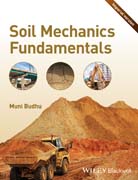
This accessible, clear and concise textbook strikes a balancebetween theory and practical applications for an introductorycourse in soil mechanics for undergraduates in civil engineering,construction, mining and geological engineering. Soil Mechanics Fundamentals lays a solid foundationon key principles of soil mechanics for application in laterengineering courses as well as in engineering practice. Withthis textbook, students will learn how to conduct a siteinvestigation, acquire an understanding of the physical andmechanical properties of soils and methods of determining them, andapply the knowledge gained to analyse and design earthworks, simplefoundations, retaining walls and slopes. The author discusses and demonstrates contemporary ideasand methods of interpreting the physical and mechanical propertiesof soils for both fundamental knowledge and for practicalapplications. The chapter presentation and content is informed by moderntheories of how students learn: Learning objectives inform students what knowledge andskills they are expected to gain from the chapter. Definitions of Key Terms are given which students maynot have encountered previously, or may have been understood in adifferent context. Key Point summaries throughout emphasize the mostimportant points in the material just read. Practical Examples give students an opportunity to see howthe prior and current principles are integrated to solve real world problems. INDICE: TABLE OF CONTENTS. .PREFACE .NOTES FOR STUDENTS AND INSTRUCTORS.chapter 1 COMPOSITION ANDPARTICLE SIZES OF SOILS.1 Introduction.Learning outcomes.2 Definition ofkey terms.3 Compositionof soils. Soil Formation. Soil Types. Soil Minerals. Surface Forces and Adsorbed Water. Soil Fabric .4 Determination of Particle Size. Particle Size ofCoarse–Grained Soils. Particle Size of Fine–Grained Soils .5 Characterization of Soils Based on Particle Size .6 Comparison ofCoarse–Grained and Fine–Grained Soils for Engineering Use.7 Summary. Exercises .chapter 2 PHASE RELATIONSHIPS, PHYSICALSOIL STATES AND SOIL CLASSIFICATION.1 Introduction.Learning outcomes. .2 Definition ofkey terms.3 PhaseRelationships.4 PhysicalStates and Index Parameters of Fine–Grained Soils.5 Determinationof the Liquid, Plastic, and Shrinkage Limits.Casagrande Cup Method ASTM D 4318.Plastic Limit Test ASTM D 4318.Shrinkage Limit ASTM D 427 and D4943 .. 6. SoilClassification Schemes..American Society for Testing and Materials and the Unified SoilClassification System (ASTM–CS). AASHTO Soil Classification System. Plasticity Chart.. 7. Engineering UseChart . 8. Summary..PracticalExamples .Exercises.chapter 3 SOILS INVESTIGATION.1 Introduction.Learning outcomes.2 Definition ofkey terms.3 Purposes of aSoils Investigation.4 Phases of aSoils Investigation.5 SoilsExploration Program.Soils Exploration Methods. Geophysical methods. Destructive methods. Soil Identification in theField. Number and Depths ofBoreholes. Soil Sampling. Groundwater Conditions.Types of In Situ or Field Tests.Vane Shear Test (VST) ASTM D 2573.The Standard Penetration Test (SPT) ASTM D 1586.The Cone Penetrometer Test (CPT) ASTM D 5778. Pressuremeter ASTM D 4719–87.Types of Laboratory Test.Soils Laboratory Tests.6 SoilsReport.7 Summary. Exercises. .CHAPTER 4 ONE– AND TWO–DIMENSIONAL FLOW OF WATERTHROUGHSOILS .1 Introduction.Learning outcomes.2 Definition ofkey terms.3 One–Dimensional Flow of Water Through Saturated Soils.4 Flow of WaterThrough Unsaturated Soils.5 EmpiricalRelationships for k.6 Flow Parallelto Soil Layers.7 Flow Normalto Soil Layers.8 EquivalentHydraulicConductivity .9 LaboratoryDetermination of the Hydraulic Conductivity.Constant–Head Test.Falling–Head Test.10 Two–Dimensional Flow of WaterThrough Soils.11 Flownet Sketching.Criteria for Sketching Flownets.Flownet for Isotropic Soils.12 Interpretation of Flownet.Flow Rate.Hydraulic Gradient.Critical Hydraulic Gradient.Porewater Pressure Distribution.UpliftForces .13 Summary .Practical Examples .Exercises .CHAPTER 5 SOIL COMPACTION.1 Introduction.Learning outcomes.2 Definition ofkey terms.3 Benefits ofSoil Compaction.4 Theoreticalmaximum Dry Unit Weight.5 ProctorCompaction Test ASTM 1140 and ASTM 1557.6 Interpretation of Proctor Test Results.7 FieldCompaction.8 CompactionQuality Control.Sand Cone ASTM D 1556.Balloon Test ASTM D 2167.Nuclear Density Meter ASTM D 2922, ASTM D 5195.Comparison Among the Popular Compaction Quality ControlTests.9 Summary.Practical Example .Exercises. .chapter6 STRESS FROMSURFACE LOADS AND THE PRINCIPLE OF EFFECTIVE STRESS.1 Introduction.Learning outcomes.2 Definition ofkey terms.3 VerticalStress Increase in Soils from Surface Loads.Regular shaped surface loads on a semi–infinite half–space.How to use the charts.Infinite Loads. Vertical stress below arbitrarilyshaped area.4 Total andeffective stresses. Total and effective stresses dueto geostatic stress fields. Effects of Capillarity. Effects of seepage.5 Lateralearth pressure at rest.6 Fieldmonitoring of soil stresses.7 Summary .Practical Example .Exercises .chapter 7 SOILSETTLEMENT .1 Introduction.Learning outcomes.2 Definition of keyterms.3 Basic concept.4 Settlement of freedraining coarse–grained soils.5 Settlement ofnon–free draining soils.6 The one–dimensionalconsolidation test.Drainage path.Instantaneous load .Consolidation under a constant load primaryconsolidation.Effective stress changes.Effects of loading history.Effect of soil unit weight or soil density.Determination of void ratio at the end of a loading step.Determination of compression and recompression indices.Determination of the modulus of volume change.Determination of the coefficient of consolidation. Root timemethod (square root time method). Log timemethod.Determination of the past maximum vertical effective stress. Casagrande s method. Brazilian method. Strain energy method.Overconsolidation ratio .Determination of the secondary compressionindex . .7 Relationship Between Laboratory and Field Consolidation.8 Calculation ofprimary consolidation settlement.Effects of unloading/reloading of a soil sample taken from thefield.Primary consolidation settlement of normally consolidatedfine–grained soils.Primary consolidation settlement of overconsolidatedfine–grained soils.Procedure to calculate primary consolidation settlement.9 Secondarycompression.10 Settlement of thick soil layers.11 One–dimensional consolidation theory.12 Typical values of consolidation settlementparameters and empirical relationships.13 Monitoring soil settlement.14 Summary. PracticalExample . Exercises .chapter 8 SOILSTRENGTH .1 Introduction.Learningoutcomes .2 Definition of keyterms.3 Basic concept.4 Typical response ofsoils to shearing forces. Effects of increasingthe normal effective stress. Effects ofoverconsolidation ratio and relative density. Effects of drainageof excess porewater pressure. Effects ofcohesion. Effects of soiltension and saturation. Effects ofcementation .5 Three modelsfor interpreting the shear strength of soils.Coulomb s failure criterion.Mohr–Coulomb failure criterion.Tresca failure criterion.6 Factors affectingthe shear strength parameters.7 Laboratory tests todetermine shear strength parameters. A simple test to determine the critical state friction angle ofclean coarse–grained soils. Shear box or direct shear test ASTM D 3080. Conventional triaxial apparatus. Direct simple shear.8 Specifyinglaboratory strengthtests .9 Estimating soilparameters from in situ (field) tests. Vane Shear Test(VST) ASTM D 2573. The StandardPenetration Test (SPT)– ASTM D 1586. ConePenetrometer Test (CPT)– ASTM D 5778.10 Some empirical and theoretical relationships for shear strength parameters.11 Summary.Practical Examples .Exercises.appendix A DERIVATION OF THEONE–DIMENSIONAL CONSOLIDATION THEORY.Appendix B MOHR CIRCLE FOR FINDINGSTRESS STATES.Appendix C FREQUENTLY USED TABLES OF SOILPARAMETERS AND CORRELATIONS.Appendix D COLLECTION OF EQUATIONS.REFERENCES .INDEX
- ISBN: 978-0-470-57795-0
- Editorial: Wiley–Blackwell
- Encuadernacion: Rústica
- Páginas: 440
- Fecha Publicación: 29/05/2015
- Nº Volúmenes: 1
- Idioma: Inglés
